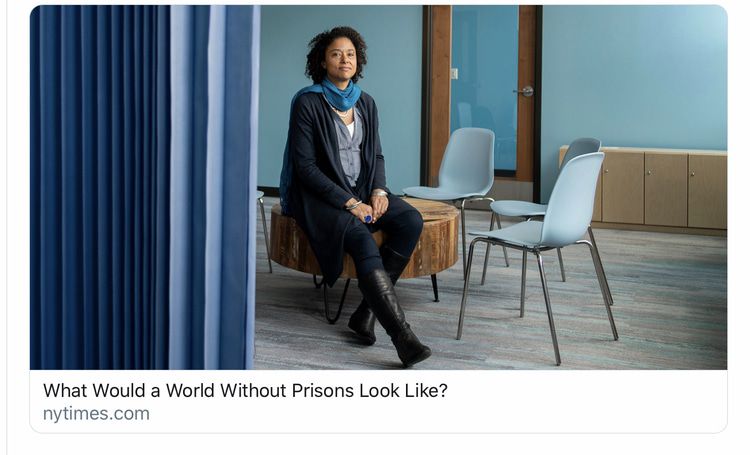From the NYT’s Art & Design section an article that brings together several favorite iSteve topics:
What Would a World Without Prisons Look Like?
The architect Deanna Van Buren designs civic spaces that are healing alternatives to correctional facilities.
By Patricia Leigh Brown
March 6, 2020
Vicente Martinez, 18, was apprehensive the first time he visited the former drug house in Syracuse, N.Y. The building had been transformed into the Center for Court Innovation’s peacemaking program, where issues can bubble up and be resolved outside of the traditional criminal justice system. “I was messing up a lot,” Mr. Martinez recalled of his two previous stints in jail for driving a stolen vehicle across county lines. “I was doing dumb kid’s stuff.”
The Syracuse peacemaking project encourages a non-adversarial approach. Joining Mr. Martinez in chairs arranged in a circle was his father, Robert, who was incarcerated for bank robbery at roughly the same age as his son. He was desperate for Vicente to avoid the same downward trajectory.
For nearly a year, difficult conversations between son, father and other family members took place in a serene setting with sky-blue walls, pine floors, a communal kitchen and lots of natural light.
Uh, anybody represent the folks whose cars the kid stole?
Okay, here is Ms. Van Buren’s big design breakthrough: some plastic chairs around a round wooden table with a mobile above of pillows to imitate clouds.
![]()
Judging from this picture, A World Without Prisons would chiefly differ from our world in being more color-coordinated in shades of blue.
iSteve commenter Alden notes:
Intelligent selection of furniture. If the table’s solid wood it’s too heavy to be picked up and used to smash someone’s head. Looks to be about 40 inch diameter, too wide for one person to pick up. Flimsy plastic chairs can be picked up but too flimsy to do much harm They also look very uncomfortable. So participants will be eager to leave.
Back to the NYT:
These touches came out of a community design process led by Deanna Van Buren, an architect who has dedicated her career to rethinking the architecture of justice. …
Ms. Van Buren, 47, co-founder of the Oakland-based nonprofit firm Designing Justice/Designing Spaces, has committed her architecture practice to the question of “what a world without prisons could look like,” the title of her popular TED Talk. …
Ms. Van Buren’s path to Designing Justice/Designing Spaces was circuitous: Growing up in a split-level house in a white gated community, she recalls as a young woman feeling “tribeless.” not feeling fully at home in either white or black culture.
In 21st Century American culture, our natural rulers are assumed to be those from the Obama-like Biracial Elite, who grew up in nice white neighborhoods, but who have enough black body so that they no doubt have tragic stories about white children touching their hair.
She was five years old when her family moved into a segregated neighborhood in rural Virginia. Ms. Van Buren’s father, a retired pipe organist and music professor, would drive past the imposing white-porticoed courthouse with his daughter and warn his little girl to stay out of trouble because the justice system was a perilous trap if you were black. His words instilled her with fear. …
Her efforts have dovetailed with growing public acknowledgment of racial bias inherent in the criminal justice system. …
… “The intensity of her focus has allowed her to become a leader,” said Deborah Berke, the dean of the Yale School of Architecture, which has brought criminal and restorative justice issues into its core curriculum.
The restorative justice space is a sun-filled aerie that can safely accommodate emotionally wrenching conversations. Cases will be referred by the district attorney and deal with crimes committed by adolescents, such as vehicle and laptop theft, robbery or assault. The design goes a step further than Syracuse by offering “cooling off” areas, separate entrances for sensitive cases and a blackboard for tussling out reparations.
Here’s the blackboard:
![]()
It looks like the reparations are supposed to come not from the car thief but from YT.
… Not all the projects function exactly as planned: Her firm designed a $250,000 mobile classroom for the nonprofit Five Keys Schools and Programs in San Francisco that provides free education in neighborhoods marked by poverty, violence and low high school graduation rates. The classroom is a retrofitted municipal bus outfitted with Wi-Fi, desks and a library. But the old bus was retired for a reason: it is prone to breakdowns, temperature swings and mold. If the windshield wipers or turn signal go on the fritz, the classroom winds up in the shop. “Like a model home, the first impression is what they’re going for,” John Beiser, a teacher, said. …
Beyond architecture, Ms. Van Buren retains an activist spirit. In Oakland, she shares an apartment with two roommates — one Jewish and the other Palestinian.
Yet she can — on occasion — step away from the intensity of her work. She marched in costume in last year’s 1811 Slave Rebellion Re-enactment organized by the New York artist Dread Scott.
“In acting out the story, there was real healing there,” she said. Partial to immersive experiences, she is a regular at Burning Man and celebrated her 47th birthday at the “Wizarding World of Harry Potter” at Universal Studios (she bought a wand).
After all, she knows that rethinking the architecture of justice is a long game.
“I think of her as a phoenix,” said Ms. Winn of Atlanta. “The passion of the work is in her genes.”
iSteve commenter Alden notes:
I keep having to remind myself it’s 2020, not 1970. All this was effected starting around 1965. It didn’t work and by 1985 it was tough on crime again. These things go on cycles and we’re in for a long 30 year high crime cycle.
[Comment at Unz.com]















